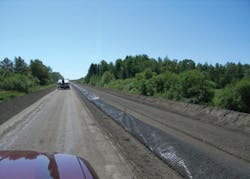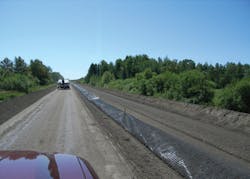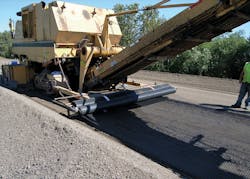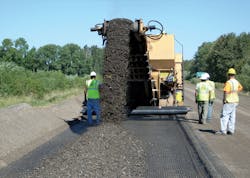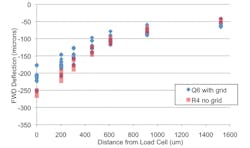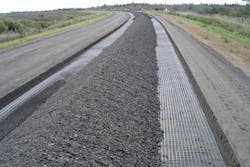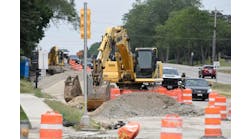By: John Siekmeier, P.E., and Jim Bittmann, P.E.
Moving Ahead for Progress in the 21st Century (MAP-21) is the federal law that lit a fire under state departments of transportation.
It called on them to institutionalize asset management and performance standards as they implement innovative technologies, practices, and policies. MAP-21 and Fixing America’s Surface Transportation (FAST Act) are federal laws expected to improve past practice, enhance stewardship of our transportation infrastructure, and deliver a sustainable transportation system that supports prosperity and opportunity. One of the major reasons why the DOTs were created was to design and construct our interstate highways. The DOTs have proven to be very efficient constructors because their organizational structures and processes were optimized to apply existing standards efficiently. However, these legacy organizations are generally not as well-suited to effectively implement new ideas which optimize the operation of the system our nation requires today. In addition, because pavement and bridge conditions traditionally receive much of the media attention and legislative directives, the value and performance of other critical assets may not always get the attention they deserve. To achieve long-term performance, it is important that our federal laws encourage other assets to be considered (NCHRP Project 24-46).
Transportation agencies need to look beyond the two traditional asset categories to better understand the impact of all assets on the transportation system in order to manage them responsibly and cost effectively. Including a broader array of assets is necessary because all of today’s transportation needs cannot be met with yesterday’s technologies, practices and policies. Government must always look for better ways to complete its fundamental mission to be good stewards of the assets entrusted to them by the people they serve. By demonstrating a renewed good-faith effort to deploy innovative solutions, transportation organizations do their part to enhance service delivery and improve the condition of our transportation infrastructure. Effective innovation deployment can enhance infrastructure investment outcomes and help us avoid adverse financial consequences such as wasted labor, wasted energy and wasted resources.
Additional consequences resulting from ineffective infrastructure investment are inadequate roadway maintenance, reduced public confidence in our stewardship and a lessening of the public’s willingness to provide additional investment through increased taxes. More effective innovation deployment has the potential to mitigate some of these negative consequences by demonstrating a renewed effort to maintain and improve our shared roadway assets.
The Minnesota DOT contends with several unique road challenges that the geogrid project is intended to help address, among them areas previously covered by glaciers, former wagon trails with substandard native soil materials and roads constructed over what was once swampland. Geosynthetics have been used successfully in several areas, including Minnesota TH 72, pictured above.
Following a recommendation
The Minnesota DOT (MnDOT) is implementing innovative technology by utilizing geogrid to enhance geotechnical asset performance. The project is an example of actions recommended by the American Society of Civil Engineers to raise the grade of roadway infrastructure in Minnesota. The project promotes innovative practices that reduce costs and improve project delivery, and was made possible by the helpful participation of a technical advisory panel with members representing the Minnesota Local Road Research Board and MnDOT, technical liaison Bruce Tanquist, student interns Amy Guo and Joe Casanova, Braun Intertec, Ingios Geotechnics, Itasca Consulting Group, Tensar International, and many university professors and graduate students. This project received the University of Minnesota Center for Transportation Studies 2018 Research Partnership Award because it demonstrated a successful partnership that is encouraging a culture of innovation by patiently and persistently implementing new technology.
In Minnesota the geotechnical assets include the embankments, slopes, retaining walls and constructed subgrades that contribute to the performance of our transportation system. Geotechnical components, such as geogrids and geotextiles, steel anchorages, concrete materials, and drainage features are improvements within geotechnical assets that help the asset perform as expected during routine loading as well as extreme events (NCHRP Project 24-46). Geogrid can be split into three broad categories: uniaxial, biaxial and triaxial. Uniaxial geogrid provides tensile stiffness and strength mainly in one planar direction. Biaxial geogrid provides tensile stiffness and strength both longitudinally and laterally. Triaxial geogrid provides additional deformation resistance due to its triangular truss-like structure. The benefits of geogrid reinforced aggregate base have been well quantified during the last decade in many publications that include the extensive study by Munir Nazzal in 2007 up to the recently published study by the National Cooperative Highway Research Program (NCHRP Project 1-50).
In northern Minnesota, geogrid has traditionally been used to provide a more stable construction platform by improving the strength of the pavement foundation when weak soils are present. A more recent geogrid application provides additional stiffness to the aggregate base layer, which can then more effectively protect the underlying soil layers from traffic loads. Northern Minnesota has some unique challenges in building and maintaining roads. A portion of this area was covered with glaciers, which left a wide variety of terrain and materials that the roads have been built with and placed on. Another challenge is that the majority of the roads were just wagon trails, which have been slowly upgraded over the years. Ideal materials were not always available during construction and materials close at hand were usually incorporated into these roads. This included constructing roads over swamps where organic material was left in place. These issues, combined with deep frozen ground during the long winters, result in many challenges as the Minnesota DOT and local governments serve their northern customers.
Figure 1. Test results at 9 kips as collected by a Dynatest Model 8002E FWD.
Option heavy
Given these challenges, engineers have experimented with and implemented a variety of ways to improve, upgrade, and just maintain the roads. Geosynthetics have given engineers additional options to repair and improve roads more successfully than ever before. This concept is new compared to other options, such as corduroy timbers, which have been used in the past. Geosynthetics provide a wider variety of options, and because they are relatively easy to install, geosynthetics have become one of the primary tools used to address road issues. In particular, geogrid has been widely used in a variety of scenarios including strengthening reclaimed bases. This geogrid application is very useful because the roadway can remain open to traffic throughout construction. During the past 15 years, more than 40 miles of geogrid reinforced aggregate base have been installed in northwest Minnesota with great success. The primary scenarios where geogrid has been deployed are during roadway widening, to reduce reflective cracking, and where differential settlement is likely due to differing soil conditions or organics, especially problematic near culverts.
Geogrid reinforcement is known to help increase aggregate compaction during construction, and also it has been observed to improve the long-term performance of roadways. However, because greater justification of this long-term performance expectation was desired, an investigation was undertaken by MnDOT in three phases to better understand and quantify the structural benefit of geogrid on the performance of asphalt surfaced roadways. The current work by MnDOT builds on these previous studies and specifically addresses the benefits of geogrid reinforced aggregate base at lower strains by applying the distinct element method to better understand the geogrid-aggregate interaction. In addition, the importance of moisture is quantified by including capillary tensile forces between aggregate particles.
Phase one of the investigation combined the analyses completed by Braun Intertec with analyses using MnDOT’s mechanistic empirical pavement design program, MnPAVE-Flexible. During the spring of 2013, Braun Intertec conducted falling weight deflectometer measurements on two trunk highways in northern Minnesota’s Bemidji District to compare roadways built with geosynthetics to roadways built without geosynthetics. Two of the test sections were investigated in more detail by MnDOT using the information delivered by Braun Intertec. Layered elastic analyses were used to estimate the stiffness of the pavement surface and foundation layers of a test section that included biaxial geogrid and the second test section that did not.
The FWD measurements by Braun Intertec were collected using a Dynatest Model 8002E FWD. A ¼-mile baseline subsection for each test section was selected to perform tests in 50-ft intervals. Outside of these baseline segments, tests were performed every 1⁄8 mile to allow comparison of spatial variability. At each test point a total of four drops were applied, two drops at approximately 6 kips and two drops at approximately 9 kips. The drops at 9 kips are shown in Figure 1.
The measured deflections from test section Q6, which contained geogrid, were compared to test section R4, which had no geogrid. Figure 1 shows that geogrid reduces deflection in some test sections, but that the deflection measurements are affected by the spatial variability of the soils and the full-depth reclaimed aggregate base.
It also was difficult to measure the relative benefit of geogrid when the measured deflections are small due to high stiffness of the asphalt and full-depth reclaimed aggregate base caused by the low springtime temperatures. As a result, it was confirmed that geogrid provided a benefit, but a quantitative measure of that benefit was uncertain due to variability in the test sections. It was concluded that the geogrid generally reduced pavement deflection, but it was not possible to accurately quantify the performance benefit due to variability of the recycled aggregate base produced by full-depth reclamation and the variability of the underlying soil layers.
Phase two of the investigation began in 2014 when Itasca Consulting Group was contracted by MnDOT to enhance its distinct element software, Particle Flow Code 3D (PFC3D). PFC3D was then used to estimate the increased stiffness of geogrid reinforced aggregate base for use in MnPAVE-Flexible. The conclusions from phase two resulted in a geogrid gain factor based on field and laboratory testing combined with the numerical analyses performed using both PFC3D and MnPAVE-Flexible.
Solid performance
Most recently, phase three of the investigation was completed resulting in a performance specification for geogrid reinforced aggregate base. This phase applied the dynamic cone penetrometer (DCP) and lightweight deflectometer (LWD) to test the aggregate base reinforced with geogrid during construction. These quality assurance devices, in particular the DCP, are familiar to the construction inspection staff in Minnesota. Therefore, this performance specification is expected to be readily implemented during construction quality assurance. To briefly summarize, test locations are selected to accurately represent the constructed aggregate base layer and the DCP or LWD is placed at the appropriately prepared test location. For both the DCP and LWD, a falling weight is raised and released to deliver a predetermined number of drops that result in a measured penetration (DCP-MV) or plate displacement (LWD-MV), which is then compared to a predetermined target value (DCP-TV or LWD-TV).
These construction quality assurance target values are based on the required pavement foundation strength and stiffness determined during pavement design. MnDOT’s flexible pavement design method, MnPAVE-Flexible, links the design inputs to these construction measurements and estimates pavement life. MnPAVE-Flexible is being modified using pavement material enhancements added to the PFC3D distinct element software. This enhanced software simulates cyclic triaxial compression laboratory testing and field testing of an unsaturated aggregate base containing geogrid. The geogrid provides lateral restraint to the aggregate base as a result of interlocking and friction between the geogrid and the aggregate particles. The macroscopic system properties are affected by the microstructural properties. Therefore, the modeled system can be used to study and quantify the effect of the microstructural properties on the macroscopic system such as the stress-strain relationship produced during cyclic triaxial tests at different confining stresses. The macrostructural properties specific to the geogrid include aperture shape and structural stiffness. The microstructural properties of the geogrid include rib dimensions, rib stiffness and rib surface friction. The microstructural properties of the aggregate base include particle size, particle type (density, Young’s modulus, Poisson’s ratio and surface friction), moisture content (tensile stress and separation distance) and initial aggregate base porosity.
Geosynthetics are used to stabilize subgrade materials in areas that either have questionable soils or a history of poor or substandard reinforcement. MnDOT is studying the effectiveness of them.
Something to gain
A geogrid gain factor adjustment is being used for MnDOT pavement design on projects where geogrid is being considered. The current work builds on previous studies and specifically addresses the benefits of geogrid reinforced aggregate base at lower strains by applying the distinct element method to better understand the aggregate-geogrid interaction. In addition, the importance of moisture is quantified mechanistically by applying suction (tensile stress) between aggregate particles at defined separation distances. The enhanced pavement design methods and performance specifications provide a mechanistically defensible model for aggregate-geogrid interaction. In conclusion, these innovative technologies, practices, and policies are being used to improve pavement design methodology in Minnesota by estimating geogrid gain factors and unsaturated gain factors for typical roadway configurations in which the aggregate size distribution, initial porosity, moisture content, and confining stress are varied.
About The Author: Siekmeier and Bittmann are with the Minnesota DOT.
